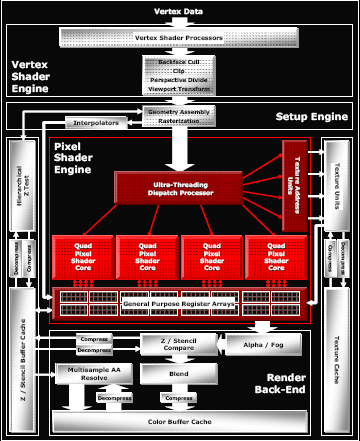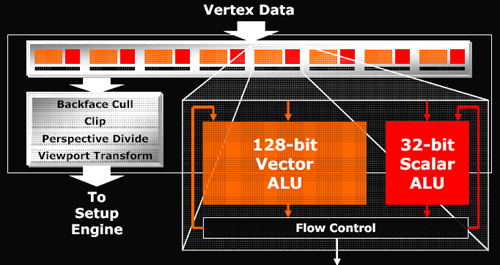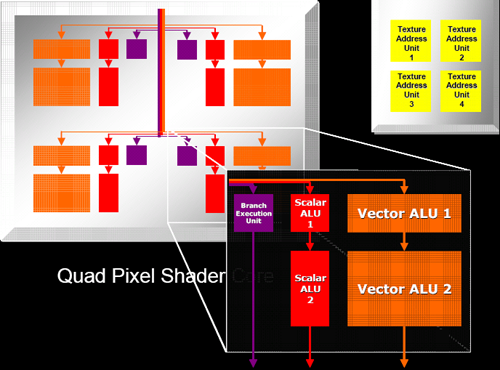ATI's Late Response to G70 - Radeon X1800, X1600 and X1300
by Derek Wilson on October 5, 2005 11:05 AM EST- Posted in
- GPUs
Pipeline Layout and Details
The general layout of the pipeline is very familiar. We have some number of vertex pipelines feeding through a setup engine into a number of pixel pipelines. After fragment processing, data is sent to the back end for things like fog, alpha blending and Z compares. The hardware can easily be scaled down at multiple points; vertex pipes, pixel pipes, Z compare units, texture units, and the like can all be scaled independently. Here's an overview of the high end case.

The maximum number of vertex pipelines in the X1000 series that it can handle is 8. Mid-range and budget parts incorporate 5 and 2 vertex units respectively. Each vertex pipeline is capable of one scalar and one vector operation per clock cycle. The hardware can support 1024 instruction shader programs, but much more can be done in those instructions with flow control for looping and branching.

After leaving the vertex pipelines and geometry setup hardware, the data makes its way to the "ultra threading" dispatch processor. This block of hardware is responsible for keeping the pixel pipelines fed and managing which threads are active and running at any given time. Since graphics architectures are inherently very parallel, quite a bit of scheduling work within a single thread can easily be done by the compiler. But as shader code is actually running, some instruction may need to wait on data from a texture fetch that hasn't completed or a branch whose outcome is yet to be determined. In these cases, rather than spin the clocks without doing any work, ATI can run the next set of instructions from another "thread" of data.
Threads are made up of 16 pixels each and up to 512 can be managed at one time (128 in mid-range and budget hardware). These threads aren't exactly like traditional CPU threads, as programmers do not have to create each one specifically. With graphics data, even with only one shader program running, a screen is automatically divided into many "threads" running the same program. When managing multiple threads, rather than requiring a context switch to process a different set of instructions running on different pixels, the GPU can keep multiple contexts open at the same time. In order to manage having any viable number of registers available to any of 512 threads, the hardware needs to manage a huge internal register file. But keeping as many threads, pixels, and instructions in flight at a time is key in managing and effectively hiding latency.
NVIDIA doesn't explicitly talk about hardware analogous to ATI's "ultra threading dispatch processor", but they must certainly have something to manage active pixels as well. We know from our previous NVIDIA coverage that they are able to keep hundreds of pixels in flight at a time in order to hide latency. It would not be possible or practical to give the driver complete control of scheduling and dispatching pixels as too much time would be wasted deciding what to do next.
We won't be able to answer specifically the question of which hardware is better at hiding latency. The hardware is so different and instructions will end up running through alternate paths on NVIDIA and ATI hardware. Scheduling quads, pixels, and instructions is one of the most important tasks that a GPU can do. Latency can be very high for some data and there is no excuse to let the vast parallelism of the hardware and dataset to go to waste without using it for hiding that latency. Unfortunately, there is just no test that we have currently to determine which hardware's method of scheduling is more efficient. All we can really do for now is look at the final performance offered in games to see which design appears "better".
One thing that we do know is that ATI is able to keep loop granularity smaller with their 16 pixel threads. Dynamic branching is dependant on the ability to do different things on different pixels. The efficiency of an algorithm breaks down if hardware requires that too many pixels follow the same path through a program. At the same time, the hardware gets more complicated (or performance breaks down) if every pixel were to be treated completely independently.
On NVIDIA hardware, programmers need to be careful to make sure that shader programs are designed to allow for about a thousand pixels at a time to take the same path through a shader. Performance is reduced if different directions through a branch need to be taken in small blocks of pixels. With ATI, every block of 16 pixels can take a different path through a shader. On G70 based hardware, blocks of a few hundred pixels should optimally take the same path. NV4x hardware requires larger blocks still - nearer to 900 in size. This tighter granularity possible on ATI hardware gives developers more freedom in how they design their shaders and take advantage of dynamic branching and flow control. Designing shaders to handle 32x32 blocks of pixels is more difficult than only needing to worry about 4x4 blocks of pixels.
After the code is finally scheduled and dispatched, we come to the pixel shader pipeline. ATI tightly groups pixel shaders in quads and is calling each block of pixel pipes a quad pixel shader core. This language indicates the tight grouping of quads that we already assumed existed on previous hardware.

Each pixel pipe in a quad is able to handle 6 instructions per clock. This is basically the same as R4xx hardware except that ATI is now able to accommodate dynamic branching on their dedicated branch hardware. The 2 scalar, 2 vector, 1 texture per clock arrangement seems to have worked with ATI in the past enough for them to stick with it again, only adding 1 branch operation that can be issued in parallel with these 5 other instructions.
Of course, branches won't happen nearly as often as math and texture operations, so this hardware will likely be idle most of the time. In any case, having separate hardware for branching that can work in parallel with the rest of the pipeline does make relatively tight loops more efficient than what they could be if no other work could be done while a branch was being handled.
All in all, one of the more interesting things about the hardware is its modularity. ATI has been very careful to make each block of the chip independent of the rest. With high end hardware, as much of everything is packed in as possible, but with their mid-range solution, they are much more frugal. The X1600 line will incorporate 3 quads with 12 pixel pipes alongside only 4 texture units and 8 Z compare units. Contrast this to the X1300 and its 4 pixel pipes, 4 texture units and 4 Z compare units and the "16 of everything" X1800 and we can see that the architecture is quite flexible on every level.
The general layout of the pipeline is very familiar. We have some number of vertex pipelines feeding through a setup engine into a number of pixel pipelines. After fragment processing, data is sent to the back end for things like fog, alpha blending and Z compares. The hardware can easily be scaled down at multiple points; vertex pipes, pixel pipes, Z compare units, texture units, and the like can all be scaled independently. Here's an overview of the high end case.

The maximum number of vertex pipelines in the X1000 series that it can handle is 8. Mid-range and budget parts incorporate 5 and 2 vertex units respectively. Each vertex pipeline is capable of one scalar and one vector operation per clock cycle. The hardware can support 1024 instruction shader programs, but much more can be done in those instructions with flow control for looping and branching.

After leaving the vertex pipelines and geometry setup hardware, the data makes its way to the "ultra threading" dispatch processor. This block of hardware is responsible for keeping the pixel pipelines fed and managing which threads are active and running at any given time. Since graphics architectures are inherently very parallel, quite a bit of scheduling work within a single thread can easily be done by the compiler. But as shader code is actually running, some instruction may need to wait on data from a texture fetch that hasn't completed or a branch whose outcome is yet to be determined. In these cases, rather than spin the clocks without doing any work, ATI can run the next set of instructions from another "thread" of data.
Threads are made up of 16 pixels each and up to 512 can be managed at one time (128 in mid-range and budget hardware). These threads aren't exactly like traditional CPU threads, as programmers do not have to create each one specifically. With graphics data, even with only one shader program running, a screen is automatically divided into many "threads" running the same program. When managing multiple threads, rather than requiring a context switch to process a different set of instructions running on different pixels, the GPU can keep multiple contexts open at the same time. In order to manage having any viable number of registers available to any of 512 threads, the hardware needs to manage a huge internal register file. But keeping as many threads, pixels, and instructions in flight at a time is key in managing and effectively hiding latency.
NVIDIA doesn't explicitly talk about hardware analogous to ATI's "ultra threading dispatch processor", but they must certainly have something to manage active pixels as well. We know from our previous NVIDIA coverage that they are able to keep hundreds of pixels in flight at a time in order to hide latency. It would not be possible or practical to give the driver complete control of scheduling and dispatching pixels as too much time would be wasted deciding what to do next.
We won't be able to answer specifically the question of which hardware is better at hiding latency. The hardware is so different and instructions will end up running through alternate paths on NVIDIA and ATI hardware. Scheduling quads, pixels, and instructions is one of the most important tasks that a GPU can do. Latency can be very high for some data and there is no excuse to let the vast parallelism of the hardware and dataset to go to waste without using it for hiding that latency. Unfortunately, there is just no test that we have currently to determine which hardware's method of scheduling is more efficient. All we can really do for now is look at the final performance offered in games to see which design appears "better".
One thing that we do know is that ATI is able to keep loop granularity smaller with their 16 pixel threads. Dynamic branching is dependant on the ability to do different things on different pixels. The efficiency of an algorithm breaks down if hardware requires that too many pixels follow the same path through a program. At the same time, the hardware gets more complicated (or performance breaks down) if every pixel were to be treated completely independently.
On NVIDIA hardware, programmers need to be careful to make sure that shader programs are designed to allow for about a thousand pixels at a time to take the same path through a shader. Performance is reduced if different directions through a branch need to be taken in small blocks of pixels. With ATI, every block of 16 pixels can take a different path through a shader. On G70 based hardware, blocks of a few hundred pixels should optimally take the same path. NV4x hardware requires larger blocks still - nearer to 900 in size. This tighter granularity possible on ATI hardware gives developers more freedom in how they design their shaders and take advantage of dynamic branching and flow control. Designing shaders to handle 32x32 blocks of pixels is more difficult than only needing to worry about 4x4 blocks of pixels.
After the code is finally scheduled and dispatched, we come to the pixel shader pipeline. ATI tightly groups pixel shaders in quads and is calling each block of pixel pipes a quad pixel shader core. This language indicates the tight grouping of quads that we already assumed existed on previous hardware.
Each pixel pipe in a quad is able to handle 6 instructions per clock. This is basically the same as R4xx hardware except that ATI is now able to accommodate dynamic branching on their dedicated branch hardware. The 2 scalar, 2 vector, 1 texture per clock arrangement seems to have worked with ATI in the past enough for them to stick with it again, only adding 1 branch operation that can be issued in parallel with these 5 other instructions.
Of course, branches won't happen nearly as often as math and texture operations, so this hardware will likely be idle most of the time. In any case, having separate hardware for branching that can work in parallel with the rest of the pipeline does make relatively tight loops more efficient than what they could be if no other work could be done while a branch was being handled.
All in all, one of the more interesting things about the hardware is its modularity. ATI has been very careful to make each block of the chip independent of the rest. With high end hardware, as much of everything is packed in as possible, but with their mid-range solution, they are much more frugal. The X1600 line will incorporate 3 quads with 12 pixel pipes alongside only 4 texture units and 8 Z compare units. Contrast this to the X1300 and its 4 pixel pipes, 4 texture units and 4 Z compare units and the "16 of everything" X1800 and we can see that the architecture is quite flexible on every level.










103 Comments
View All Comments
GoatMonkey - Wednesday, October 5, 2005 - link
What?!?! But it's **EXTREME**kilkennycat - Wednesday, October 5, 2005 - link
...there is an old saying. "Wait to see the whites of their eyes before shooting". Pre-orders mean nothing and delivery dates can change. Never ever order from a vendor that has a pre-order queue, unless you really don't care when you get the item. Who knows where you are in this queue? Few, if any of such vendors ever give you this information - for the obvious reason that thery don't want to risk losing the order. The first shipment might be 5 pieces and you are 20th on the list. Order product from vendors like Newegg or ZipZoomFly that sell only from available stock, but also have immediate auto e-mail notification when a sold-out item is back in stock... first come, first serve then of course, but at least the customer is never ever 'left hung out to dry'.I personally view vendors with pre-order queues as somewhat sleazy, but maybe my view is extreme. A pre-order queue is entirely to the benefit of the vendor and not the customer.
southpawuni - Wednesday, October 5, 2005 - link
Bad results from ATI.Look at the midrange.. I'm guessing most people around here buy that hardware (6800GT/7800GT)..
disappointing day for ATI.
Since the NV cards have been out, and are priced right.. I dont see much hope for ATI now.
bob661 - Wednesday, October 5, 2005 - link
I was expecting the new ATI cards to be a bit more competitive especially given that they'll be more expensive. Wow, what a shocker! The X1600 isn't even worth buying at less than or equal to 6600GT performance at 6800GT prices. What a bargain!!!segagenesis - Wednesday, October 5, 2005 - link
They are simply arriving late to the game. I curious see how anyone will really want the X1800 XL over the 7800 GT, consideing the price.And why no show all the cards on each graph? Why is the 7800 GT missing on the Day of Defeat graph? Are we not trying to compare cards?
Questar - Wednesday, October 5, 2005 - link
Simple - Image quality.It's been reported just about everywhere else that Nvidia lowered the image quality on the 7800 to gain speed. The image quality comparison in this review proves it.
Questar - Wednesday, October 5, 2005 - link
Heh, modded down by the Nvidia fanboys already!How about this guys, enable HDR and AA in any game you would like on a 7800. Oops, can't do it!
Open your eyes and look at the AF charts in this review. ATI has better AF, period.
segagenesis - Wednesday, October 5, 2005 - link
They looked like crap to me honestly. And where are you getting this crap about no AA/HDR on nVidia cards? Are you trying to troll? No wonder you got modded down.Questar - Wednesday, October 5, 2005 - link
It's not crap. A 7800 can't do HDR and AA at the same time. Read the HOCP review where they explain this.JarredWalton - Wednesday, October 5, 2005 - link
It was mentioned in this article as well. However, HDR already kills performance, and HDR + AA is going to be unplayable on anything short of Crossfired X1800 XT cards. Then again, HDR at 1600x1200 really isn't dying for 4xAA support, and I think many people looking at HDR are running very high-end displays and GPUs.